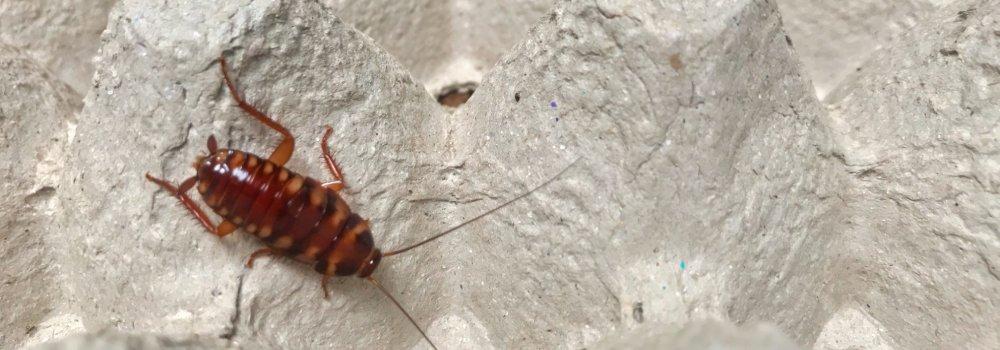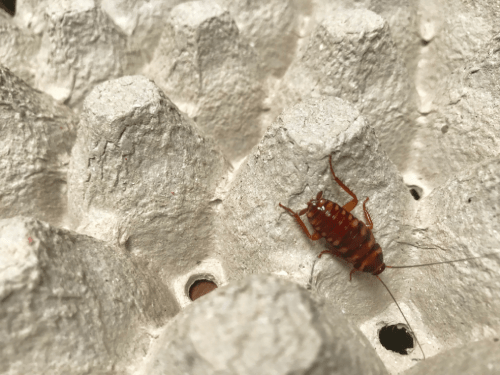
What are Brown-Banded Cockroaches (and How to Get Rid of Them)
August 15, 2022
By Daniel Baldwin, BCE, CCFS, CP-FS
Even those with a high tolerance for insects can find themselves shuddering at the sight of a cockroach. With their propensity to live in less-than-sanitary locations and tendency to jump up when startled, it’s understandable that these critters can scare many of us.
Brown-banded cockroaches are a specific type of roach common throughout North America. While they do like to make their way into homes, there are some preventative measures you can take to keep brown-banded cockroaches out. Learn more about how to recognize these cockroaches, what they eat, whether they’re dangerous, and how to get them out of your home if they do get inside.
What are brown-banded cockroaches?
Brown-banded cockroaches are an exceedingly common type of roach that are relatively small, growing to only about half an inch. While this might not feel like much solace when one jumps out at you before flying away, consider yourself lucky that it’s not one of the eight-inch Megaloblatta longipennis that you might find in Peru, Ecuador, and Panama.
What do brown-banded cockroaches look like?
As their name suggests, these roaches have distinctive tan stripes on their red-brown bodies. The stripes on brown-banded cockroaches are most apparent when the insects are young and become less visible as they age. Similar to most roach species, the brown-banded cockroach has a hardened exoskeleton, making them tough and resilient.
The wings of the male brown-banded cockroach are longer than the female’s and they can often hide their banding. The females’ wings are underdeveloped, which means that only the males can actually fly, although both males and females will jump when surprised.
Where do brown-banded cockroaches live?
Geographically speaking, brown-banded cockroaches can be found almost everywhere in North America, although they are more common in the south, the midwest, and parts of the northeastern U.S. Other species of roaches prefer more moderate temperatures, but the brown-banded cockroach thrives in areas where the median temperature is around 80 degrees Fahrenheit.
Unlike the German cockroach that prefers to live lower to the ground in rooms that have plentiful water and food sources, brown-banded cockroaches will travel to higher locations within your home when they’re not feeding. If you spot a roach up on a shelf or behind hanging wall art, it’s likely a brown-banded cockroach, as this behavior is fairly unique to this species.
How long do brown-banded cockroaches live?
Brown-banded cockroaches live 6-8 months, on average. While this might not sound like a long time, keep in mind that they are one of the most prolific breeders among roach species.
Each brown-banded cockroach egg case contains an average of 18 eggs, so two roaches can quickly become an infestation.
What do brown-banded cockroaches eat?
Brown-banded cockroaches are omnivorous, eating essentially any food products they can find within your home. They prefer foods that are high in starch content, like book bindings, stamps, or glue used for wallpaper. They are opportunistic eaters and will feed on any food products that are available. It’s essential that countertops, sinks, oven tops, floors, etc. are free of food items, dirty dishes, and spills. Sinks full of crusty dishes are a cockroach buffet. They also enjoy liquid spills or food that isn’t sealed.
Are brown-banded cockroaches dangerous?
These roaches are known to spread disease and illness from the environments they inhabit. They pick up bacteria on their legs and spread it onto plates, utensils and food items. If humans come into contact with this bacteria, it may cause gastrointestinal troubles. In addition, the molted skins and droppings from these cockroaches can cause or trigger allergies, even in people who are otherwise healthy.
What are brown-banded cockroaches attracted to?
What attracts a brown-banded cockroach is pretty straightforward—food, shelter, and water. Brown-banded cockroaches need warm temperatures, which is why they often enter temperature-regulated homes and buildings and don’t thrive as much in very cold climates. They also need a constant source of food and aren’t picky eaters, eating almost anything that’s made of organic material. Because of this, places like your kitchen cabinets, heated garage shelving, laundry room storage, and food or linen pantries are the most attractive.
Do brown-banded cockroaches infest?
Yes. Brown-banded cockroaches are known to infest homes. They’re one of the most challenging cockroach species to eliminate. Brown-banded cockroaches can get into thin boxes and loose or unsealed bags, contaminating food and other goods quickly. An infestation can grow out of control in a matter of weeks because these cockroaches breed rapidly. It’s always best to use a professional pest control company to handle these pests efficiently.
Why do I have brown-banded cockroaches?
Brown-banded cockroaches can end up in your home without any other reason than they were looking for food and shelter and found an easy way in. However, the most common way they enter homes is when already-infested items are brought into your home unknowingly, like furniture, food products, grocery items, and even electronics. Especially if you buy any thrift, second-hand, or antique items, always check them thoroughly for signs of an infestation before bringing them into your home. (This is also a common way that bed bugs can make their way into your home.) Keep an eye on the groceries you purchase and avoid anything with rips, tears, or unsealed edges. If you find any signs like these, discard them immediately in a sealed bag away from your house.
How to get rid of brown-banded cockroaches
Due to their small size, brown-banded roaches can hide in places that larger species aren’t able to fit into, which means that they can easily hide and evade extermination efforts. If you suspect that you may have an issue with cockroaches but you’re not positive, try a baited cockroach trap in your home for a week to see if you catch any.
Once you do confirm the presence of the brown-banded cockroach, you’ll need to act quickly to prevent the infestation from growing. Certain chemicals are helpful in controlling cockroach populations; however, only some are available to the public. To gain access to these effective treatments, it’s best to call a professional pest control service. They are trained in placing traps effectively, have access to the right pesticides, and they’ll also do a thorough survey of your home in order to put together a pest control plan for your home.
To prevent these roaches from coming back, enhance those cleaning habits and wash dirty dishes, dry spills, and store food products properly.
RELATED POSTS





